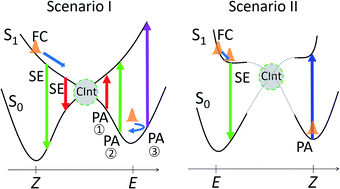Vibrational coherence and quantum yield of retinal-chromophore-inspired molecular switches†
Abstract
UV-Vis transient absorption (TA) spectroscopy is used to carry out a systematic investigation of the ultrafast C![[double bond, length as m-dash]](https://www.rsc.org/images/entities/char_e001.gif) C double photoisomerization dynamics and quantum yield of each isomer of a set of six chromophores based on the same retinal-inspired, indanylidene pyrrolinium (IP) molecular framework. All compounds undergo a sub-picosecond photoisomerization, and can be categorized within two photoisomerization scenarios. Scenario I corresponds to compounds which display the signatures of a vibrationally coherent reactive motion through the conical intersection, with different degrees of vibrational coherence. Qualitatively distinct TA signatures are observed for other compounds which are therefore proposed to obey scenario II, referring to an intermediate regime between scenario I and a thermally-equilibrated, fully stochastic photoreaction. Remarkably, the photoisomerization scenario is observed to correlate with the computed distortion from planarity of the ground state equilibrium geometry, reflecting the torsional strain that would be released after photoexcitation. The most planar compounds – i.e. those having a C
C double photoisomerization dynamics and quantum yield of each isomer of a set of six chromophores based on the same retinal-inspired, indanylidene pyrrolinium (IP) molecular framework. All compounds undergo a sub-picosecond photoisomerization, and can be categorized within two photoisomerization scenarios. Scenario I corresponds to compounds which display the signatures of a vibrationally coherent reactive motion through the conical intersection, with different degrees of vibrational coherence. Qualitatively distinct TA signatures are observed for other compounds which are therefore proposed to obey scenario II, referring to an intermediate regime between scenario I and a thermally-equilibrated, fully stochastic photoreaction. Remarkably, the photoisomerization scenario is observed to correlate with the computed distortion from planarity of the ground state equilibrium geometry, reflecting the torsional strain that would be released after photoexcitation. The most planar compounds – i.e. those having a C![[double bond, length as m-dash]](https://www.rsc.org/images/entities/char_e001.gif) C double bond pre-twist of less than 10° – obey scenario II, while compounds obeying scenario I have larger pre-twists. The most pre-twisted compounds (>15°) show pronounced oscillatory signatures of a reaction-induced, low-frequency vibrational wavepacket observed in the S0 photoproduct and assigned to the torsion mode of the reaction coordinate, thus mimicking the vibrationally coherent photoisomerization dynamics of the rhodopsin protein. Importantly, the systematic comparison of all photoisomerization quantum yields does however not reveal any correlation with observables such as excited state life time, vibrational coherence, absorption wavelengths or degree of pre-twisting.
C double bond pre-twist of less than 10° – obey scenario II, while compounds obeying scenario I have larger pre-twists. The most pre-twisted compounds (>15°) show pronounced oscillatory signatures of a reaction-induced, low-frequency vibrational wavepacket observed in the S0 photoproduct and assigned to the torsion mode of the reaction coordinate, thus mimicking the vibrationally coherent photoisomerization dynamics of the rhodopsin protein. Importantly, the systematic comparison of all photoisomerization quantum yields does however not reveal any correlation with observables such as excited state life time, vibrational coherence, absorption wavelengths or degree of pre-twisting.

- This article is part of the themed collection: Quantum effects in complex systems


 Please wait while we load your content...
Please wait while we load your content...